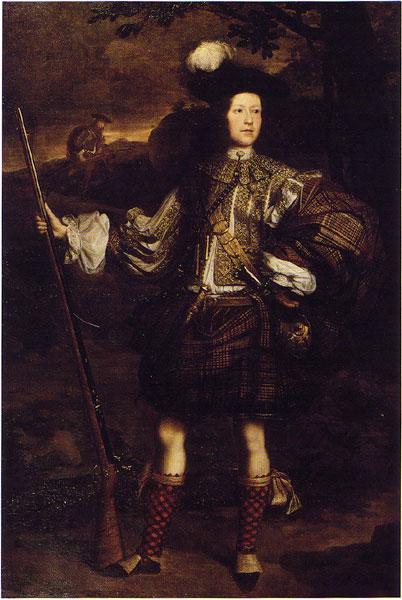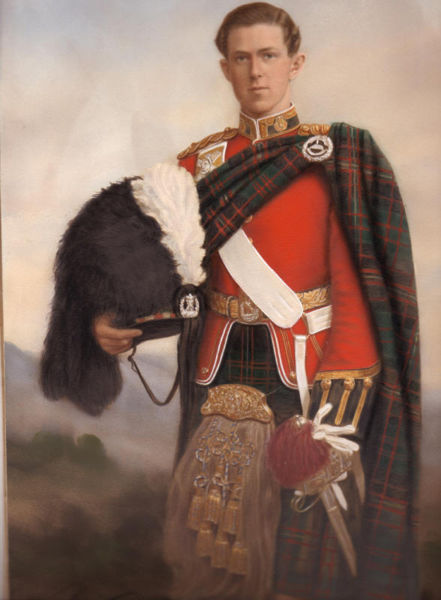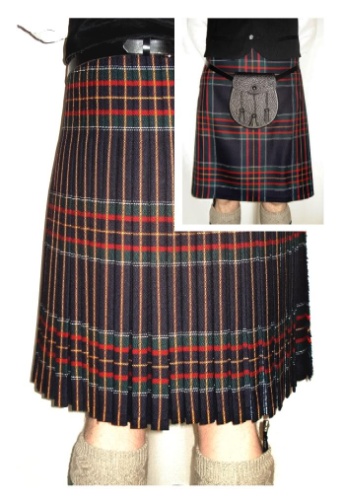| This Week’s Topic… | |||||||

Best viewed in
|
An Abbreviated History of the Kilt The history of the kilt stretches back to at least the end of the 16th century. Although the kilt is an item of traditional Scottish highland dress, the nationalism of that tradition is relatively recent. It was only with the Romantic Revival of the 19th century that the kilt became irreversibly associated with Highlanders, and was subsequently adopted by Lowlanders and the Scottish Diaspora. Other modern Celts such as the Irish, Cornish, Welsh and Manx, have also adopted tartan kilts in recent times, although to a lesser degree. The word kilt comes from the Scots word kilt (fancy that) meaning to tuck up the clothes around the body. The Scots word derives from the Old Norse kilting, from Norse settlers who wore a similar, non-tartan pleated garment.
Although the kilt was largely forgotten in the Scottish Highlands, during those years it became fashionable for Scottish romantics to wear kilts as a form of protest against the ban. This was an age that romanticized "primitive" peoples, which is what Highlanders were viewed as. Most Lowlanders had viewed Highlanders with fear before 1745, but many identified with them after their power was broken. The kilt, along with other features of Gaelic culture, had become identified with Jacobitism, and now that this had ceased to be a real danger it was viewed with romantic nostalgia. Once the ban was lifted in 1782, Highland landowners set up Highland Societies with aims including "Improvements" (which others would call the Highland clearances) and promoting "the general use of the ancient Highland dress". The Celtic Society of Edinburgh, chaired by Walter Scott, encouraged lowlanders to join this antiquarian enthusiasm. The kilt became identified with the whole of Scotland with the pageantry of the visit of King George IV to Scotland in 1822, even though 9 out of 10 Scots lived in the Lowlands. Scott and the Highland societies organized a "gathering of the Gael" and established entirely new Scottish traditions, including Lowlanders wearing the supposed "traditional" garment of the Highlanders. At this time many other traditions such as clan identification by tartan were developed. After that point the kilt gathered momentum as an emblem of Scottish culture as identified by antiquarians, romantics, and others, who spent much effort praising the "ancient" and natural qualities of the kilt. King George IV had appeared in a spectacular kilt, and his successor Queen Victoria dressed her boys in the kilt, widening its appeal. The kilt became part of the Scottish national identity.
Setts (Tartan Patterns) One of the most distinctive features of the authentic Scottish kilt is the tartan pattern, or sett, they exhibit. Many of these patterns have come to be associated with Scottish clans or families, but there are also tartans for districts, counties, countries, corporations, States and Provinces, schools and universities, individuals, commemorative, and simple generic patterns that anybody can wear. Setts are always arranged horizontally and vertically, never on the diagonal. They are specified by their thread count, which is the sequence of colors and their units of width. Setts are further characterized by their size which is the number of inches (or centimetres) in one full repeat. The size of a given sett depends not only on the number of threads in the repeat, but also on the weight of the fabric. This is so because the heavier is the fabric weight, the thicker the threads will be and thus the same number of threads of a heavier weight fabric will occupy more space when woven. The colors given in the thread count are specified as in heraldry, although tartan patterns are not heraldic. The exact shade which is used is a matter of artistic freedom and will vary from one fabric mill to another as well as from one dye lot to another within the same mill. Tartans are commercially woven in four standard color variations that describe the overall tone. "Ancient" or "Old" colors are characterized by a slightly faded look intended to resemble the vegetable dyes that were once used. Ancient greens and blues are lighter in shade, while reds appear orange. "Modern" colors are bright and show off modern alkaline dyeing methods. The colors are bright red, dark hunter green, and usually navy blue. "Weathered" or "Reproduction" colors simulate the look of older cloth weathered by the elements. Greens turn to light brown, blues become gray, and reds are a deeper wine color. The last color variation is "Muted" which tends to earth tones. The greens are olive, blues are slate blue, and red are an even deeper wine color. This means that of the nearly 5,000 registered tartans available there are four possible color variations for each, resulting in nearly 20,000 tartans. Setts are registered with the Scottish Tartans Authority which maintains a collection of fabric samples characterized by name and thread count. In all, there are approximately 5000 registered tartans. Although many tartans being added every year, most of the registered patterns available today were created in the 19th century by commercial weavers who had a large variety of colors to work with. The rise of Highland romanticism and the growing Anglicization of Scottish culture by the Victorians at the time led to registering tartans with clan names. Before then, most of these patterns had little or no connection to any clan. There is therefore nothing symbolic about the colors, and nothing about the patterns is a reflection on the status of the wearer.
|
||||||



